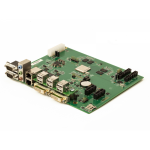Curve ball thrown before London Show finally lands!
First announced the night before this year’s London Show, at which it was being demonstrated on the RISC OS Open stand, Elesar Ltd‘s Titanium motherboard is now on sale and shipping.

The board comes in two forms, one with RISC OS 5.23 and the other with Linux, though it is only the RISC OS version that is currently available. It is based around a Sitara 1.5GHz Cortex-A15 applications processor, and supplied with RISC OS, which is programmed to start up from the on board boot flash.
Whereas the other modern boards on which RISC OS runs, such as the BeagleBoard or the Raspberry Pi, were developed for other purposes, and RISC OS was ported to run on them by some very talented people, the Titanium board was designed from the outset with RISC OS in mind.
The board, which is priced at £415.00 plus VAT and postage, features:
- A Texas Instruments AM5728 Sitara Processor, which features dual Cortex-A15, Cortex-M4 IPU, C66x floating point DSP, and SGX544 3D GPU cores – though note that RISC OS doesn’t at present benefit from all of that.
- 8MB of operating system boot flash, preprogrammed with RISC OS 5.23
- 2GB of DRAM and 2.5MB of on chip fast SRAM.
- Two gigabit Ethernet sockets.
- Two DVI video connections – though with RISC OS, using the second currently shows a test card.
- Six rear USB ports and two more potentially available from the front via a connector on the board.
- A four port SATA interface for hard disc, SSD, or optical drives.
- Two serial ports.
- A micro-SD card socket.
- Stereo audio out, with mono downmix to internal 8ohm speaker.
- Two PCI express sockets for expansion cards such as parallel ports.
- A real time clock, configuration EEPROM, and unique ID chip.
- Connections for standard front panel power/reset buttons and status LEDs.
The board’s dimensions are 6.7″ by 8″ – which is Mini-DTX – with mounting holes to match those found on ATX and micro ATX motherboards, which means the Titanium should fit comfortably in the commonly available ATX form factor cases.
Optional accessories available include a printed Technical Reference Manual and I/O back panel.
To make use of the board, you will obviously need to source a suitable case and power supply, along with all the usual peripherals – mouse, keyboard, screen (with a DVI-D or DVI-I input) and so on. The power supply in particular needs to be ATX12V version 2.3 or later compliant; earlier versions had minimum load currents, below which they may not switch on – and the low-powered Titanium may be below that minimum.
For those who may be a little more squeamish about turning a motherboard and components sourced elsewhere into a working machine, another option would be to purchase a complete system, with the board already put together with components tested and known to be suitable. Elesar Ltd doesn’t offer complete systems, so recommends contacting either CJE Micro’s or R-Comp Interactive to see what they have available – or wait to see what the two companies announce themselves.



